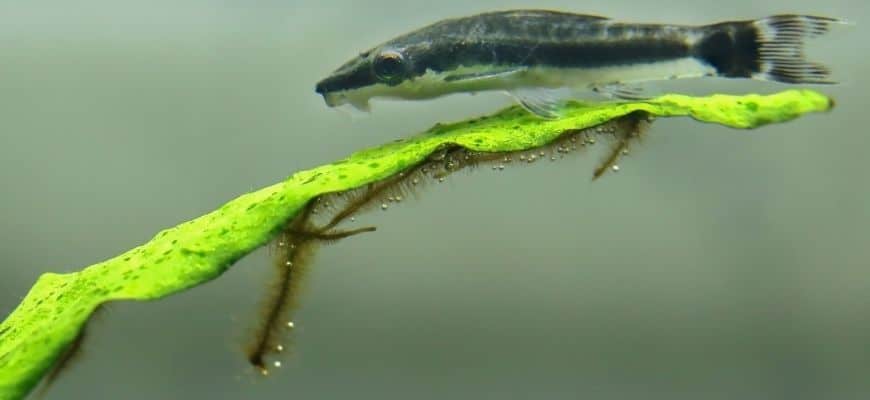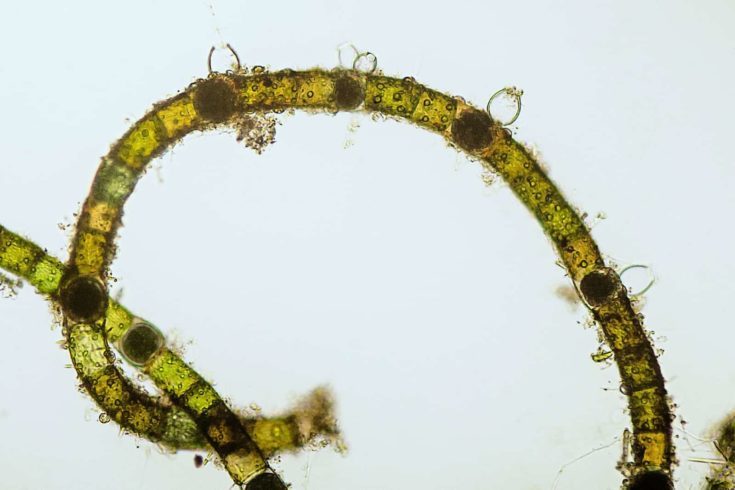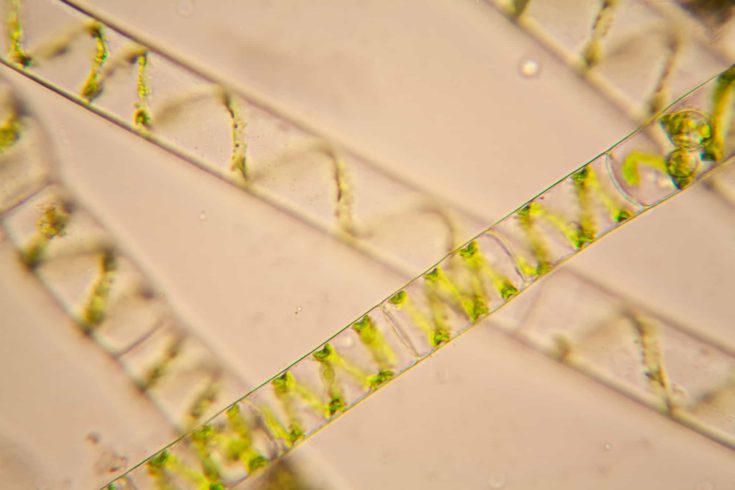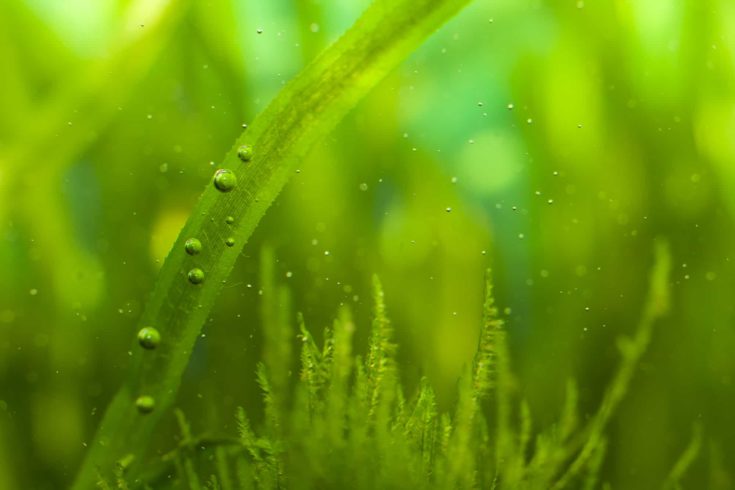All fish keepers are familiar with the curse of aquarium algae!
Whether it’s the fuzz algae that coats your viewing panes, the thread algae and white hair algae that trail from your plants, or the staghorn algae that none of your fish will eat, you want to know how to get rid of algae.
So, what causes algae in your fish tank? How many types of aquarium algae are there? And how do you get rid of them for good?
Keep reading for the answers to those questions and more!
15 Types of Aquarium Algae – Causes, Treatment, And Prevention
Now, we’re going to take a look at 15 species of aquarium algae that commonly invade home fish tanks. We’ve also included lots of helpful information on how you can prevent the slimy green menace from contaminating your aquarium in the first place!
1. Black Beard Algae (Audouinella/Black Brush Algae/BBA)

What Is Black Beard Algae?
Black Beard algae (BBA) is a species of red algae (Rhodophyta) that’s most commonly seen in marine setups, although it can sometimes appear in tropical freshwater aquariums.
As it photosynthesizes, BBA produces a red light protein known as phycoerythrin, making the colonies appear black or dark purple algae.
This species of algae is notoriously difficult to get rid of, growing very rapidly and forming thick patches that resemble a beard. BBA will quickly spread in your tank to cover driftwood, hard surfaces, and even slow-growing living plants.
Causes
- An imbalance of nutrients, typically in a new setup.
- Insufficient water changes.
- Poor fertilization.
- Phosphate depletion.
- Low CO2.
- Poor water circulation.
- Too much light or exposure to sunlight.
How To Get Rid Of Blackbeard Algae
- If the algae is growing on the viewing panes or filter equipment, use an algae scraper to remove as much as you can.
- Try overdosing the tank with Seachem Flourish Excel.
- If your plants and decorations are covered with BBA, make up a solution of 1:20 bleach and water, and dip the infected items into that for two to three minutes.
- Keep up with weekly water changes.
- Increase the amount of CO2 in your tank to boost plant growth and outcompete algae for nutrients.
- Improve the water flow around your tank by rearranging your aquascaping or upgrading your filtration system, or adding powerheads.
Black Beard Algae Eaters
- Siamese Algae Eaters
- Amano Shrimp
- Florida Flag Fish
2. Green Spot Algae (GSA/Coleochaete Orbicularis)

What Is Green Spot Algae?
Green Spot algae are so named for the tiny green spots it forms on everything in your fish tank, including plants, decorations, glass, and on filter equipment. In favorable conditions, this species of algae will spread to form extensive colonies.
Causes
- An imbalance of nutrients, typically in a new setup.
- Insufficient water changes.
- Poor fertilization.
- Phosphate depletion.
- Low CO2.
- Poor water circulation.
- Too much light or exposure to sunlight .
How To Get Rid Of Green Spot Algae
- Test the water for phosphates. If levels are low, dose the aquarium with Seachem Flourish Phosphorus to correct the imbalance.
- Use an algae scraper to remove Green Spot algae from the viewing panes.
- Consider reducing the amount of light in the tank. Less than nine hours of light is generally adequate for most plant species.
Green Spot Algae Eaters
- Sun snails (Clithon sp.)
- Nerite snails (Neritina sp.)
3. Blanket Weed (Cladophora sp.)

What Is Blanket Weed?
Blanket Weed is a total nightmare to remove!
The algae form a green, woolly mat that latches onto the substrate, hair grass, and hardscaping. If you attempt to scrub or rub Blanket Weed, it emits a very unpleasant odor.
Causes
- The introduction of poor quality plants to the setup, typically Marimo Balls.
- High levels of nitrates, light, and CO2.
- Healthy water conditions are favored.
How To Get Rid Of Blanket Weed
- Turn off the filtration system or any other form of water circulation so that you don’t inadvertently distribute the algae around the tank.
- Use a set of long aquascaping tweezers to pick out as much of the algae as possible.
- Spot-treat problem areas with Seachem Flourish Excel.
- Always quarantine new plants before introducing them to your main display tank.
Blanket Weed Algae Eaters
There are no known critters that eat Blanket Weed, probably because the algae is incredibly tough and unpalatable.
4. Fuzz Algae

What Is Fuzz Algae?
As you might guess from its name, Fuzz algae is a short, green, filamentous algae that grow over the viewing panes, ornaments, and plants, giving everything a fuzzy appearance.
It’s thought that Fuzz algae are an early growth stage of Hair algae, and a small colony in your aquarium is not a problem.
Causes
- Commonly seen in new setups that have an imbalance of nutrients.
- Nutrient imbalance and low CO2.
How To Get Rid Of Fuzz Algae
- Test your aquarium water for CO2 and nutrient levels and make any necessary adjustments
- Create the perfect environment for your plants to encourage them to outcompete the algae
- Introduce a clean-up crew of algae-eating critters (see below)
Fuzz Algae Eaters
- Amano shrimp
- Siamese Algae Eaters
- Otocinclus
- Black Mollies
- Bristlenose Plecos
5. Blue-Green Algae

What Is Blue-Green Algae?
Blue-Green algae are actually not true algae but a species of aquatic cyanobacteria that can photosynthesize. This interesting “algae” is also a nitrogen-fixing bacteria, which will eventually absorb all the nitrogen that your tank water contains.
Blue-Green algae grows very quickly, eventually coating everything in the tank in a reddish-purple, blue, brown, or dark green slime. You often find Blue-Green algae growing on the substrate or on the glass where it gets the most light.
Causes
- High levels of organic waste matter and or insufficient water changes.
- Too much light.
- Old light bulbs that don’t provide sufficient light for your plants, leaving them unable to outcompete the algae for nutrients.
- Poor water circulation.
How To Get Rid Of Blue-Green Algae
- “Blackout” your fish tank for a few days.
- Dose the tank with Maracyn.
- Add fast-growing plants to your tank to outcompete the algae
- Treat infected areas with an Excel treatment, and then remove the dead algae
- Improve water circulation in your aquarium.
Blue-Green Algae Eaters
There are no known Blue-Green algae eaters.
6. Hair/Thread Algae

What Is Hair/Thread Algae?
Hair/Thread algae is a type of filamentous algae that forms long, green threads that look like flowing hair.
This species of algae usually fixes itself to plants, although it sometimes grows on the substrate and aquarium decorations.
Causes
- Oversaturation of nutrients, typically too much iron or too much light.
- Too much light and insufficient nutrients.
- CO2 or nitrate deficit.
How To Get Rid Of Hair/Thread Algae
- Test your tank water and adjust nutrient levels if necessary
- Ensure that CO2 and nutrient levels are adequate for your plants
- Introduce a cleanup crew of algae eaters to your tank
- Manually remove the algae by using an old toothbrush. Sometimes, you can siphon out the algae during a water change
Hair/Thread Algae Eaters
- Amano Shrimp
- Mollies
- Dwarf Shrimp (Red Bee or Red Fire Shrimp)
- Siamese Algae Eater
- Florida Flag Fish
7. Brown Algae (Diatoms)

What Is Brown Algae?
Brown alga is a form of diatom that uses silicate, nitrates, and phosphorus, as well as photosynthesis to obtain the nutrients it needs. That means the algae can survive in conditions where light is poor, provided that the chemical food is available.
Brown algae is found in both saltwater and freshwater fish tanks, first appearing as a light dusting on the substrate. Within five days, the diatom morphs into a disgusting slimy coating that covers your aquarium glass, plants, and substrate.
Causes
- Insufficient lighting.
- High levels of nitrates, silicates, or phosphorus and or low oxygen levels.
- Immature fish tanks where the biological filter hasn’t completely matured.
How To Get Rid Of Brown Algae
- Deprive the algae of nutrients.
- Use a vacuum to remove the algae from the substrate and wipe down the glass.
- Perform water changes to remove nutrients.
- Adjust lighting levels.
- Ensure that your filtration system has a GPH rate of four or greater.
- Add more dissolved oxygen to the aquarium by adding an air stone or lowering the water temperature slightly.
- Consider using an RO system.
Brown Algae Eaters
- Otocinclus Catfish
- Plecostomus
- Yellow Tangs
8. Rhizoclonium Algae

What Is Rhizoclonium Algae
Rhizoclonium algae is a form of green algae belonging to the Cladophoraceae genus. This slimy, soft alga grows in fine brown or green hair-like strands rather like Hair algae.
Causes
- Poor general tank maintenance.
- Low levels of CO2 and nutrients.
- Inadequate water circulation.
How To Get Rid Of Rhizoclonium Algae
- Deep clean the aquarium.
- Increase CO2 levels.
- Check your nutrient dosing.
- Overdose the tank with Excel or EasyCarbo.
Rhizoclonium Algae Eaters
- Amano shrimp
9. Green Dust Algae (GDA)

What Is Green Dust Algae?
Green Dust algae are sometimes confused with Green Spot algae, but GDA grows in green, slimy colonies over the viewing panes of your aquarium, whereas GSA grows in spots.
Causes
- Common in new setups that are not fully cycled.
- Can appear mature tanks where CO2 and nutrients are low or out of balance.
How To Get Rid Of Green Dust Algae
- Allow four weeks for the algae to complete its life cycle – do nothing during this period.
- After four weeks, carry out a water change, lowering the water level as much as you safely can.
- Wipe the algae off the glass.
Green Dust Algae Eaters
10. Spirogyra

What Is Spirogyra?
Spirogyra is named for its spiral-shaped chloroplasts. These algae form long, fine, slippery bright green strands that can spread throughout your fish tank.
Causes
- Ammonia spikes caused by overfeeding, inadequate water changes, dead livestock, and dirty filters.
- High concentrations of micronutrients, such as iron.
- Too much light.
How To Get Rid Of Spirogyra
- Perform a three-day blackout with CO2 turned off
- At the same time, perform large daily water changes, dosing the tank with Marcos following each
- Finally, dose the tank with Excel, TNC Carbon, or EasyCarbo
Green Dust Algae Eaters
- Rosy barbs
11. Oedogonium Algae

What Is Oedogonium Algae?
Oedogonium presents as short, green, free-floating, filamentous algae that cling to your plants, giving them a fuzzy appearance.
Causes
- Low nutrients and CO2.
How To Get Rid Of Oedogonium
- Test CO2 and nutrient levels and adjust as necessary
- Overdose with Flourish Excel and EasyCarbo
Oeodogonium Algae Eaters
- Rosy barbs
- Amano shrimp
- Mollies
12. Free-Floating Algae

What Is Free-Floating Algae?
Free-Floating algae are tiny unicellular organisms that float freely in the water column without attaching themselves to anything, turning the water a cloudy green color.
Causes
- Too much light, especially sunlight.
- An overabundance of nutrients.
- Insufficient or irregular water changes.
How To Get Rid Of Free-Floating Algae
- Perform a three-day blackout procedure
- Use a UV sterilizer
Free-Floating Algae Eaters
- Shrimp
- Snails
13. Staghorn Algae (Compsopogon sp.)

What Is Staghorn Algae?
Staghorn algae are one of the red algae and are so named because it grows to resemble a stag’s antlers. This species of algae generally attaches itself to plant leaves, filter boxes, and tank decorations.
Causes
- Low CO2.
- Poor water circulation.
- Excessive nutrients caused by overfeeding or poor tank maintenance.
- Ammonia spikes, especially in new tanks that haven’t fully cycled.
How To Get Rid Of Staghorn Algae
- Manual removal using a toothbrush.
- Deep-clean your aquarium and improve your tank maintenance regimen.
- Dip all affected decorations and hardy plants in a 1:20 bleach a water solution for two to three minutes.
- Improve water circulation.
Staghorn Algae Eaters
Unfortunately, no self-respecting critter will touch Staghorn algae!
14. Red Slime Algae

What Is Red Slime Algae?
Red Slime algae are actually a species of Cyanobacteria. This form of algae grows as a slimy red film, covering decorations, equipment, and glass.
Causes
- Elevated waste levels, including nitrates and phosphate.
- Poor water circulation.
- Old light bulbs or inadequate lighting.
How To Get Rid Of Red Slime Algae
- Check and adjust phosphate and nitrate levels accordingly.
- Improve water circulation.
- Correct overfeeding and improve your general filter and tank maintenance regimen.
Red Slime Algae Eaters
- Blennies
- Tangs
- Crabs
- Sea urchins
- Snails
15. Green Aquarium Water Algae

What Is Green Aquarium Water Algae?
Green Aquarium Water algae are single-celled organisms that float freely in your fish tank, turning the water bright green. Thankfully, this pea soup is not harmful to your fish. Unfortunately, this form of algae replicates incredibly quickly.
Causes
- Ammonia spikes.
- Too much light, especially sunlight.
- Nutrient overload caused by overfeeding or infrequent water changes.
- New tank syndrome in tanks that are not fully-cycled.
How To Get Rid Of Green Aquarium Water Algae
- Perform a three-day blackout
- Use a UV sterilizer
Green Aquarium Water Algae Eaters
- Snails
- Shrimp
Tips To Avoid Algae
Although pretty much every fish tank has some form of algae growing in it, there are ways in which you can keep the degree of algae infestation under control.
Don’t Overfeed Your Fish
The primary cause of algal bloom in fish tanks is overfeeding.
Blue-green and red algae typically multiply when large quantities of dissolved organic matter are present in the aquarium. Nitrates and phosphates are also a problem when fish are overfed, and those substances provide a food source for algae.
Feed your fish only what they’ll eat in two to three minutes, and remove any uneaten food with a fish net or aquarium siphon before the food has the chance to start decomposing and leaching algae nutrients into the water.
Control Your Lighting (Avoid Direct Sunlight)
Like all plants, algae need light to photosynthesize, and they especially love direct sunlight. So, when positioning your fish tank, make sure that it doesn’t receive any sunlight that will encourage algal growth, as well as potentially raising the water temperature to uncomfortable levels for your fish.
If you have living plants in your tank, they require between eight and ten hours of light each day to grow and thrive. Limit your lighting to those hours as a maximum to help retard algal growth. If you’re not around to turn the lights on and off, invest in a timer from your local DIY store or swap your aquarium lighting unit for one that has an integral timer.
Raise The Competition
Algae use nutrients in the aquarium water in the same way as aquarium plants. So, you can raise the competition for food by including plenty of living plants in your setup, effectively starving the algae out.
Bottom line: keeping living plants in your fish tank will reduce the likelihood of algae overgrowth.
Keep On Top Of Water Changes
You should be carrying out partial water changes in your fish tank each week to maintain a safe, healthy environment for your fish. But regular water changes are also crucial in the fight against algae.
How so?
Well, algae use the nutrients in the aquarium water to grow and spread. Those nutrients include nitrates and phosphates, both of which accumulate in fish tanks with dirty water. I recommend that you change 10% to 15% of the aquarium water every week to control nutrient levels, as well as keeping the environment safe and healthy for your fish.
Remember that you also need to maintain the aquarium filter media by washing it through in tank water once a month or so. That will remove any sludge and debris that would otherwise clog the filter sponges and prevent the efficient flow of water through the filtration system. An efficient filter system ensures that the levels of nitrates in the water are kept to a minimum, effectively depriving algae of a source of nutrients.
Test Your Water Source
Tap water is treated with various chemicals to make it safe for you to drink and wash in. As you know, chemicals such as chlorine and chloramine are highly dangerous to fish, which is why you must use a water conditioner to treat the water before you add it to your aquarium.
However, did you know that tap water also contains substances such as phosphate and even nitrates? Test your tap water or well water to see what potential nasties it contains and either treat the water to make it less appealing to algae or find another water source, such as Reverse Osmosis (RO) or filtered water.
Algae Removal: Dos and Don’ts
There are a few dos and don’ts that you need to know about algae removal and control.
Don’ts
First of all, let’s take a look at the don’ts:
Don’t Impulse Buy Fish!
There are many reasons why you shouldn’t give in to temptation and buy more fish for your aquarium, purely on impulse!
- Fish species must be thoroughly researched to match your existing livestock and the tank itself.
- Many popular species of algae eaters only eat particular types of algae. Also, many of these clean-up crew fish will spurn algae altogether once they get a taste for flakes and pellets. Even worse, some fish that are sold as “algae eaters” don’t even eat algae!
At the end of the day, keeping a few algae-eating critters in your tank is not going to make much of a dent in a serious algae problem. That said, every little help, and some shrimp or snails might be a useful addition to your collection.
Don’t Settle For “Easy Fixes”
“Easy fixes” to an algae problem typically don’t prove effective in the long term, simply because they don’t address the problem that caused the outbreak in the first place.
For example, keeping your fish tank lights off for a few days will certainly wipe out algae. However, if you forget to carry out water changes, the tank will quickly become overloaded with nutrients, and the algae will return as soon as you turn the lights back on.
Don’t Be Scared Of A Little Algae
Many fish enjoy grazing on certain species of algae, and some types of algal growth can even add an attractive natural vibe to your setup.
So, don’t panic if you discover a few algae growing in your fish tank when you come to clean your viewing panes; that’s completely normal. After all, that’s why algae magnets and scrapers are sold in fish stores!
Dos
Here’s what you can do to keep down levels of algal growth.
Keep Your Aquarium Clean
Phosphates and nitrates accumulate due to poor tank maintenance, so be sure to carry out a water change every week. Also, you need to use an aquarium vacuum to remove organic matter from the substrate before it has a chance to decompose.
Keep your aquarium clean, and you’ll be rewarded with healthy fish and a much-reduced algae problem.
Use Live Plants
There are lots of easy-to-grow aquatic plants to choose from, so don’t be afraid to include plenty in your aquarium.
Plants are your allies in the fight against algae, as they outcompete the algae for nutrients, helping to keep algal growth to a minimum. Plants also produce oxygen and use carbon dioxide as they respire, helping to keep the water well oxygenated for your fish.
Finally, many shy fish species enjoy sheltering amid lush planting, which can also be a life-saver for vulnerable fry.
In Conclusion
Did you enjoy our guide to 15 different types of aquarium algae and how to treat and prevent it? If you did, please share!
Most forms of aquarium algae appear because of excess lighting, poor tank cleaning and maintenance practices leading to an overabundance of nutrients, and introduction of living plants.
Dealing with most species of algae is relatively simple, as described above. And the addition of a cleaning crew of algae-eating critters is a great way to keep algae growth under control.
Good reading! It helps me much.
Brown Algae – Get some Ramshorn Snails
I had a bad case of Brown Algae in my tank. I tried cleaning the glass, bleaching the ornaments etc, but it just kept coming back. I did find the solution in the end – Ramshorn Snails, they devoured every spot of it! My tank stays crystal clear now, plants, glass ornaments are all clean, no algae get a chance to survive.